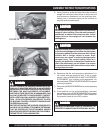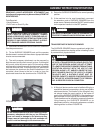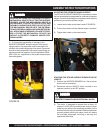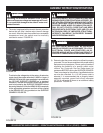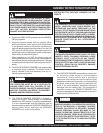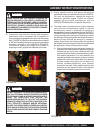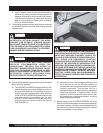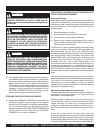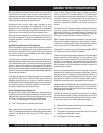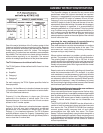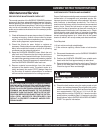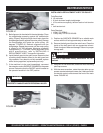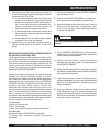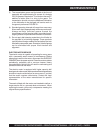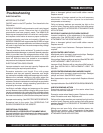
SFG10E ELECTRIC SURFACE GRINDER — OPERATION AND PARTS MANUAL — REV. #1 (07/16/07) — PAGE 29
but have different implications for the floor user. Flatness is
critical where the user’s main concern is the behavior of
wheeled type vehicles. Levelness is critical where the user’s
main concern is with fixed structures such as shelving,
racks and the placement of machine tools.
Exceptions exist, but for most users, flatness is more
important than levelness. The reasoning is that fixed
equipment can be shimmed or adjusted to compensate.
However, it is not as easy to adapt a wheeled vehicle to a
floor that is not flat enough to allow for proper action.
Flatness and levelness also have different implications for
the floor contractor. Flatness is determined mainly by
finishing methods. Levelness is determined mainly by the
side forms.
Defined Versus Random Traffic Patterns
Floors are subject to two kinds of traffic patterns: defined
and random. On a defined traffic floor, vehicle movement is
confined to fixed paths. On a random traffic floor, vehicles
are free to roam, though inevitably, some traffic patterns
are used more than others.
The distinction is important because the two kinds of traffic
demand different methods of measuring surface regularity.
On a defined traffic floor, a continuous (or nearly continuous)
profile in each of the paths can be measured. But where
traffic is random, the possible travel paths are infinite in
number. What usually results is statistical sampling; selected
points or lines are checked and assumed that they represent
the whole floor surface.
The highest degree of surface regularity is found among
the defined traffic floors. Defined traffic floors allow the
designer and contractor to focus on a limited number of
critical areas. When a defined traffic floors is out of tolerance,
it is relatively easy to identify the defects for correction—
usually by employing a grinding process.
How to Define Surface Regularity
Since the middle 1980s, new methods of defining surface
regularity have been adopted as national standards. Older
methods will continue to be utilized, although they are less
effective. The following methods will be discussed:
1) The F number system for random traffic floors
2) The TR 34 system for defined traffic floors
Both methods are not of equal value. For random traffic
floors, F numbers provide the most complete and consistent
system. For defined traffic floors, the TR34 system is
superior.
ASSEMBLY INSTRUCTIONS/OPERATIONS
The F number system utilizes a pair of numbers to define
surface regularity. The flatness number, Ff, is based upon
the curvature over a horizontal distance of 24 inches. The
levelness number, Fl, is based upon the floor slope over a
horizontal distance of 10 feet. The standard test for F
numbers is specified in ASTM E1155 and/or most recent
version.
With both Ff and Fl, higher numbers mean greater surface
regularity. Though the scale ranges from zero to infinity,
almost all floors have F numbers between 10 and 100 for
both flatness and levelness. Since the scale is linear, an
Ff50 floor is exactly twice as flat as an Ff25 floor.
Most F number specifications are written in a two tier format.
The overall F numbers apply to the floor taken as a whole.
The local F numbers apply to each individual slab and are
usually only one half to two thirds the overall values.
The overall F numbers are not just simple averages. ASTM
E1155 covers how to combine F numbers.
The two tier format encourages contractors to achieve good
surface regularity while allowing for minor defects. The
attempt is to pour the entire floor to the specified overall F
numbers. If, for instance, the construction crew has a bad
day and fails to meet the specified overall numbers for the
slab, the slab can still be accepted provided it meets the
specified local numbers.
Such an occurrence serves as a warning to the crew that it
must strive for a better performance on later slabs, so as to
bring the overall F numbers up to the specified values. If a
slab fails to meet even the specified local numbers, it must
be repaired or replaced, but such failures seldom occur if
all parties understand what is expected from the start.
Designers are not obligated to use this two tier format. Some
designers specify a single F number pair (Ff and Fl) which
applies to each individual slab. But this also raises the risk
that slabs will be rejected.
FIGURE 40 depicts the overall and minimum F numbers
for various floor classes. The floor classification is from the
American Concrete Institute. Although the F number system
is only a few years old, it offers these advantages:
a) The system controls both flatness and levelness.
b) There is a standard test method.
c) The system recognizes the statistical nature of profile
testing on random traffic floors.
d) The system is infinitely variable.



